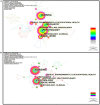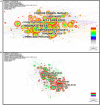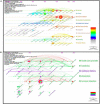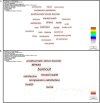A Bibliometric Analysis of the Association Between Compassion Fatigue and Psychological Resilience From 2008 to 2021
- PMID: 35814110
- PMCID: PMC9258720
- DOI: 10.3389/fpsyg.2022.890327
A Bibliometric Analysis of the Association Between Compassion Fatigue and Psychological Resilience From 2008 to 2021
Abstract
Aims: A negative association between the lower level of psychological resilience (PR) and increased risk of compassion fatigue (CF) and higher Coronavirus disease 2019 (COVID-19) stress has been revealed. However, bibliometric studies have not been performed to comprehensively investigate this topic. This study aimed to identify the status and trends in the CF and PR field from 2008 to 2021 and during the COVID-19 pandemic.
Methods: We identified relevant literature from the Web of Science Core Collection® database using "resilience" and "compassion fatigue" on September 30, 2021. All search results were exported in plain text format for collaboration network analysis, reference-based co-citation analysis, analysis of journals, and keywords-based co-occurrence analysis, which were performed using Citespace® 5.8.R1.
Results: A total of 388 publications were identified finally, and there has been an increasing trend in the annual number of publications with light fluctuations. The analysis of journals and keywords indicated that nurses and social workers are the main research targets, and their mental problems are the main research topics. The turnover intention of health care providers has been a research focus, particularly during the COVID-19.
Conclusion: The results of the present study help us understand the status of the CF and PR field and its recent developments.
Keywords: COVID-19; Web of Science; bibliometric analysis; compassion fatigue; physiological resilience.
Copyright © 2022 Yi, Liu, Tang, Cheng, Wang, Hu, Liu, Tian and Jiménez-Herrera.
Conflict of interest statement
The authors declare that the research was conducted in the absence of any commercial or financial relationships that could be construed as a potential conflict of interest.
Figures








Similar articles
-
Research hotspots and trends in healthcare workers' resilience: A bibliometric and visualized analysis.Heliyon. 2024 Jul 24;10(15):e35107. doi: 10.1016/j.heliyon.2024.e35107. eCollection 2024 Aug 15. Heliyon. 2024. PMID: 39170181 Free PMC article. Review.
-
Scars of COVID-19: A bibliometric analysis of post-COVID-19 fibrosis.Front Public Health. 2022 Sep 20;10:967829. doi: 10.3389/fpubh.2022.967829. eCollection 2022. Front Public Health. 2022. PMID: 36203683 Free PMC article.
-
Research trends and hotspots in caregiver studies: A bibliometric and scientometric analysis of nursing journals.J Adv Nurs. 2020 Nov;76(11):2955-2970. doi: 10.1111/jan.14489. Epub 2020 Aug 21. J Adv Nurs. 2020. PMID: 32820562
-
Bibliometric and visual analysis of transcranial direct current stimulation in the web of science database from 2000 to 2022 via CiteSpace.Front Hum Neurosci. 2022 Dec 1;16:1049572. doi: 10.3389/fnhum.2022.1049572. eCollection 2022. Front Hum Neurosci. 2022. PMID: 36530203 Free PMC article.
-
Bibliometric analysis of the effects of mental fatigue on athletic performance from 2001 to 2021.Front Psychol. 2023 Jan 9;13:1019417. doi: 10.3389/fpsyg.2022.1019417. eCollection 2022. Front Psychol. 2023. PMID: 36698588 Free PMC article. Review.
Cited by
-
Prevalence of Compassion Fatigue and Its Association with Professional Identity in Junior College Nursing Interns: A Cross-Sectional Study.Int J Environ Res Public Health. 2022 Nov 17;19(22):15206. doi: 10.3390/ijerph192215206. Int J Environ Res Public Health. 2022. PMID: 36429923 Free PMC article.
-
Prevalence and related factors of compassion fatigue among registered nurses and nursing students during the internship: a systematic review and meta-analysis.BMC Nurs. 2024 Dec 30;23(1):956. doi: 10.1186/s12912-024-02597-2. BMC Nurs. 2024. PMID: 39736724 Free PMC article.
-
Compassion fatigue and loneliness at work in nurses - the mediating role of resilience: a cross-sectional study.J Res Nurs. 2024 Aug;29(4-5):290-302. doi: 10.1177/17449871241238965. Epub 2024 Jul 26. J Res Nurs. 2024. PMID: 39291224 Free PMC article.
-
Impact of a Fulbright award: A bibliometric analysis of persistence.Health SA. 2025 Mar 5;30:2776. doi: 10.4102/hsag.v30i0.2776. eCollection 2025. Health SA. 2025. PMID: 40183022 Free PMC article.
References
LinkOut - more resources
Full Text Sources
Research Materials

